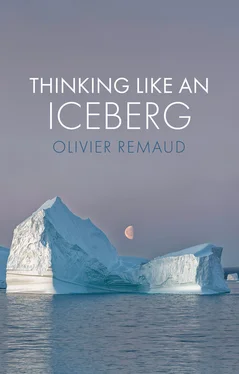The crew left the German locks at Geestemünde on 13 June 1872 on the Admiral Tegetthoff , a three-masted schooner, heading for the North Cape and then the Pole. While on the train heading to the port of embarkation, they thought they were bound to discover an island beyond the frozen desert. Sitting in comfort, they imagined green valleys, wild reindeer, a world of freedom and life without cares. So, when they finally get there, their disillusionment will be even greater. Payer notes at the outset that
an indescribable solitude lies over these snow-clad mountains . . . When ebb and flood do not lift the groaning and straining drift ice, when the sighing wind is not brushing across the stony chinks, the stillness of death lies upon the ghostly pale landscape. People speak of the solemn silence of the forest, of the desert, even of a city wrapped in night. But what a silence lies over such a land and its cold glaciered mountains lost in impenetrable, vaporous distances – its very existence must remain, so it seems, a mystery for all time . . . A man dies at the North Pole, alone, fades like a will-o’-the-wisp, while a simple sailor lifts the keen and a grace of ice and stones waits for him outside. 11
The ship is soon frozen in the ice. It is transformed into a ghastly cabin. Their ordeal begins. For months they live in a ‘a world totally alien’, threatened by erosive activity that constantly refashions the snow. Silence is short-lived. The noise of the ice floe becomes permanent. Even its more delicate variations obsess them. Sometimes icebergs ‘break with a burst of selfdestructive thunder under the glow of the sun’s rays . . .’; sometimes ‘ice dies with a hiss like a flame.’ 12
The sailors struggle against the pressures that open up dangerous cracks around their ship. They battle against these wide gaps with trunks of oak from the ship, which ‘turns, sinks and rises’ in the chaos of the ice particles. They experience periods of whiteness during which there are no forms, no contrasts, no objects and no colours. The ice absorbs everything. Their exchanges are reduced to a few inaudible monosyllables and mumblings.
They keep themselves fit as much as they can, with a strict discipline. They have a clear schedule which prescribes regular physical exercise. They read a lot. But the ice does not loosen its grip. They decide to join a floe that is drifting. During their journey they come across a ‘massive, rubble-covered iceberg’. The moment is sublime because ‘these were the first stones and boulders we had seen in a long time, limestone and argillaceous schist.’ For the sailors, these are ‘emissaries’ from a nearby land. They pick up debris and feel nostalgic for paradises lost as the iceberg disappears into the mist. A few days later, on 30 August 1873, a shoreline appears, and they name it after their king, Franz Josef. 13
One passage in Payer’s diary is very moving. It is the one where he lays bare their collective disappointment. One day, in a brief moment of insight, the crew members realised that ‘the “North Pole” [is] not a country, not an empire to be conquered, nothing but lines intersecting at a point, nothing of which can be seen in reality!’ 14Many felt this way in the second half of the nineteenth century. North Pole explorers were coveting an invisible place. They tried to locate it with the help of cartography and deductive logic. But the absurd competition between nations turned their desire for adventure into a chimera.
What value can a goal have when one can’t see it? Why reach for a geometric, purely abstract goal when snowy winds sweep across the ice, temperatures turn the body’s extremities blue, one’s own breath freezes, and companions give up the ghost one after the other? No one is fooled.
There is great power in these utopias of the far North and the far South. The years pass, the expeditions multiply, and so do the disasters. Despite some success, with each surge of national pride, catastrophes follow in their wake. Journeys to both ends of the world are transformed into funeral processions. The hulls of sailing ships may be lined and reinforced, but they are sheared with the crushing force of pieces of pack ice; terrible shipwrecks are the result. When they do escape, the ships are immobilised in the pack. Ice saws and gunpowder are useless. The vice is still closing. The officers find that their uniforms are unsuitable for the cold, that their bodies are rapidly weakening, and that they have not brought enough food with them. How can one resist such a hostile environment? With a few exceptions, the indigenous arts of survival are completely unknown to them. Entire crews leave and never come back. In European capitals docks are crowded with people awaiting their return in vain. Newspapers make headlines out of every drama the adventurers have. They increase their print runs. Sales skyrocket. Readers are hooked on sensation. Meanwhile, the pack becomes a land of ghosts.
The higher the latitude of the ships, the more the ice changes its form. Metaphors are of no use in estimating their volume or for describing their admirable variety. Icebergs can take on the features of tragic characters. They transcribe spectral atmospheres, not in glorious solitude but with the anguish of isolation. The ice tests the explorers’ nervous systems. In their notebooks, they write down their inner states. They repeat the same phrases, use the same words, experience the same feelings. When the imagination luxuriates, it is a surface effect.
They all tell their life stories. They explain the reasons that drove them to these fractured lands. They try to justify their mission’s failure and the collapse of their dreams. Silent remembrances rise from the depths of memory. The sailors note down their bizarre dreams, the hallucinations that have afflicted them, and other experiences that they have had of a supernatural character, such as yeti-like figures coming out of the fog. They are spectres, not ‘rational actors in a wild region’. 15Those who return to safety rarely return to a normal life. They become famous. But most of them are broken. The weaknesses of heroism come to light. The ice is the mausoleum of conquering nations.
The young Arthur Conan Doyle is in his third year of medical school in Edinburgh. For a taste of adventure, he breaks off his studies and embarks for a few months on the whaling ship Hope . From February to August 1880, he sails between Greenland, the Faroe Islands and Spitsbergen. He is horrified to discover what the whale hunters did. He describes the thick fogs, and several times he falls into the cold waters. Luckily, he escapes. The experience leaves its mark. In his diary, he writes about the ‘other-world feeling’ that he experienced from the very first moments, and which never left him. This other-worldly feeling haunted him with the power of an obsession. 16The budding writer did not return unscathed from his journey beyond the Arctic Circle.
In polar environments, perhaps more than anywhere else, metaphors are used as a means of orientation in an uncertain context. The captains use them, of course, to decorate the notes in their logbooks. But deep down they know that they are lifelines that help sailors to keep their minds on the job. The eye does not capture everything in front of icebergs drifting in the ocean. Such volumes seem immovable. Yet they are versatile and fleeting. Icebergs weaken the consciousness as soon as they appear. They thwart one’s intentions because they do not correspond to objects that are easy to identify. The philosopher Hans Blumenberg writes that, in everyday life, metaphor generally expresses ‘the need to incorporate, as part of the total causal system, even the most surprising event, bordering on a supposed “miracle”.’ 17
Читать дальше












